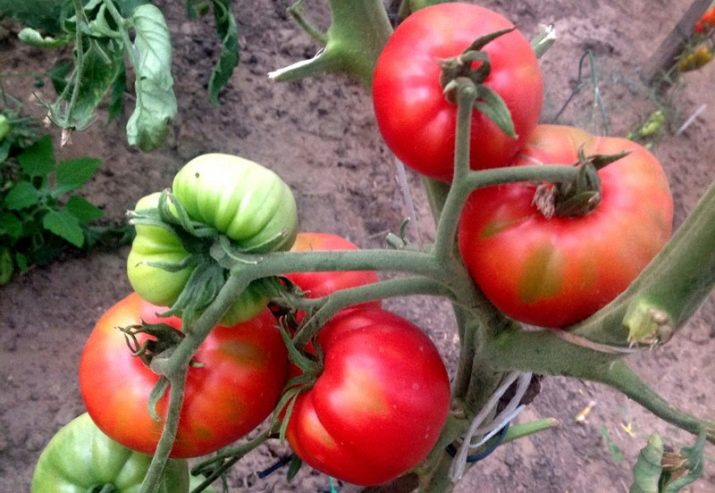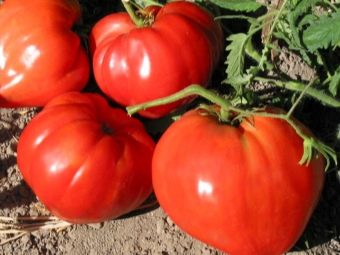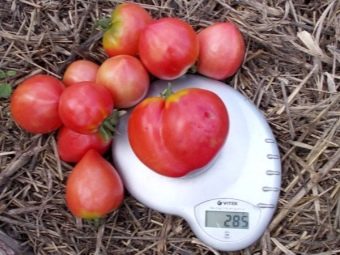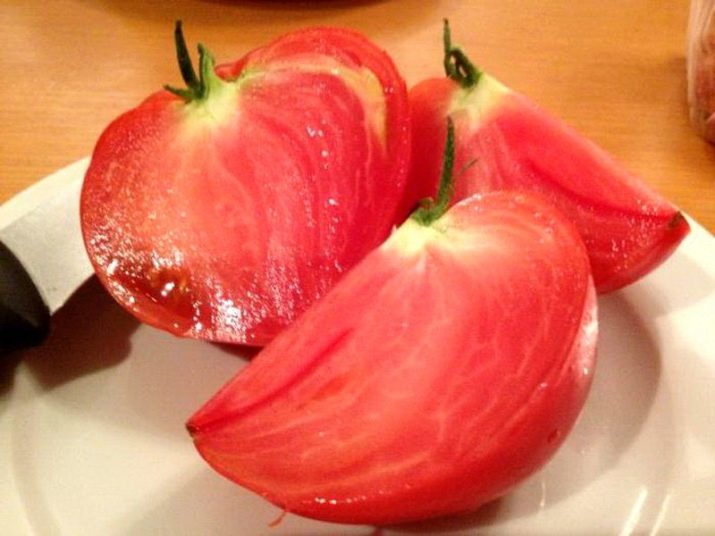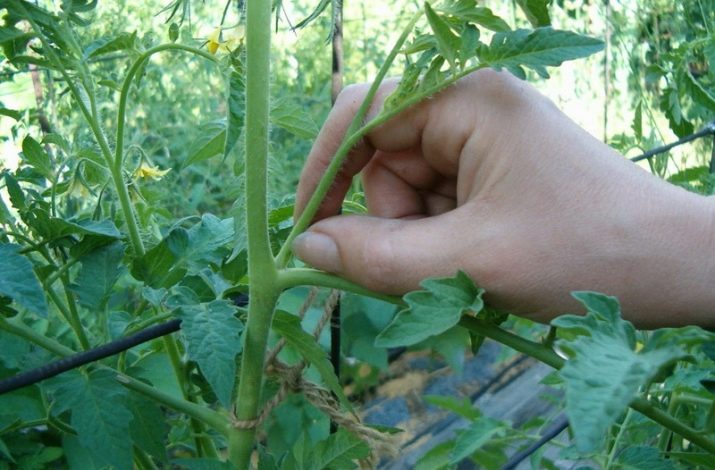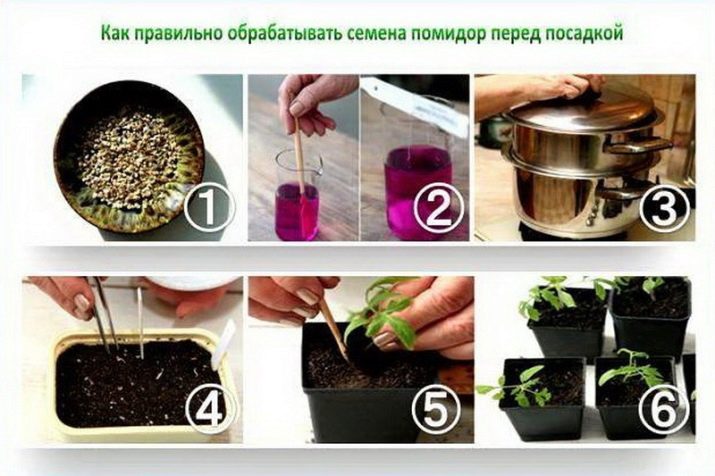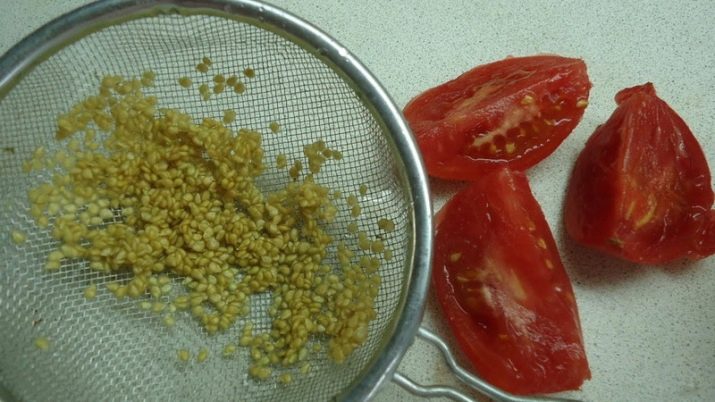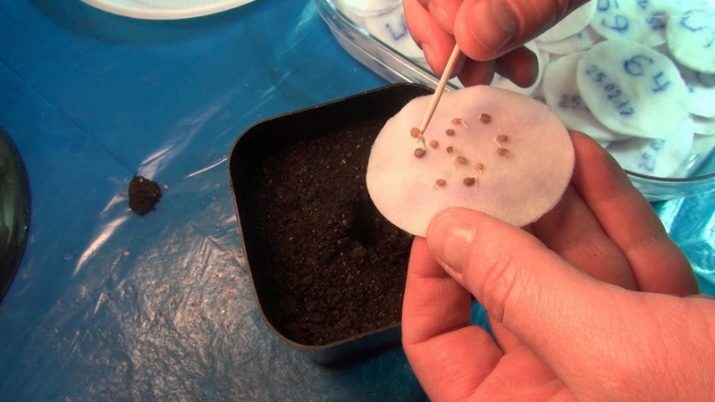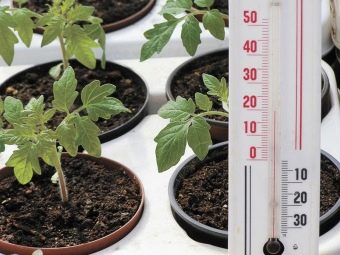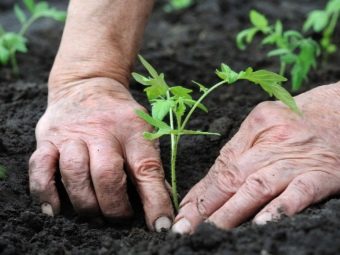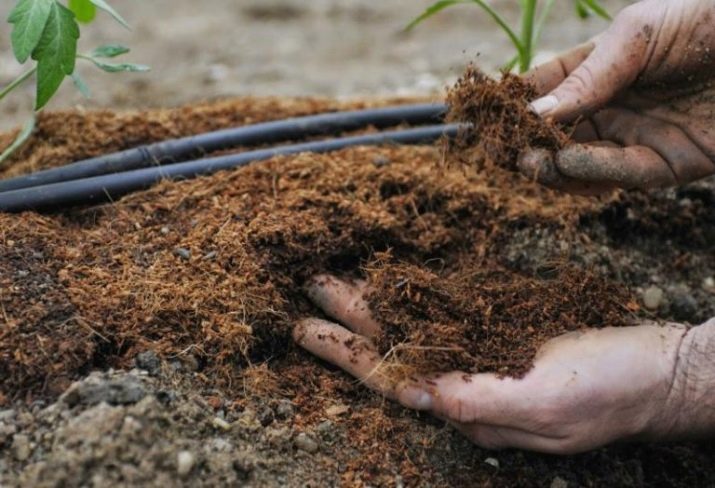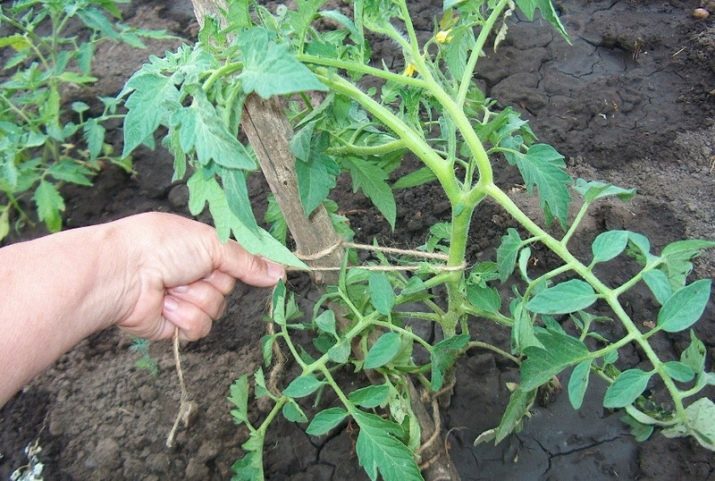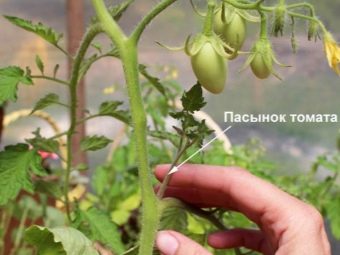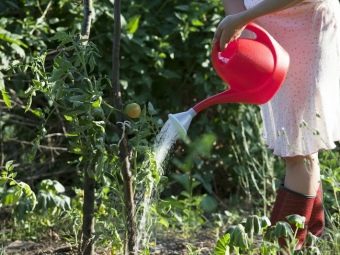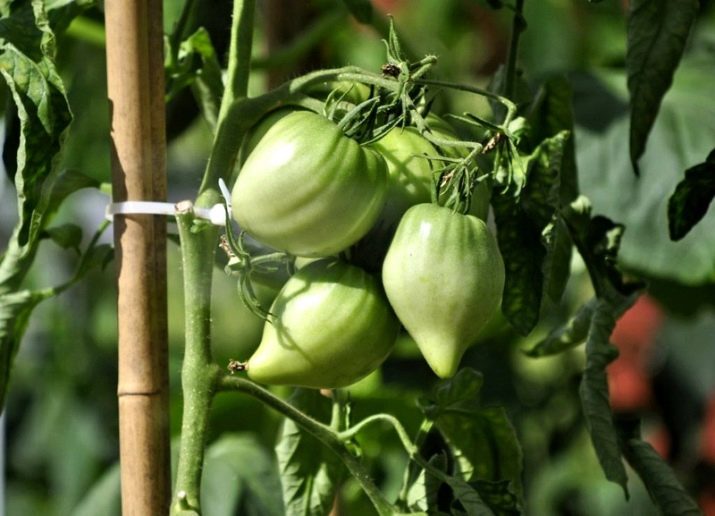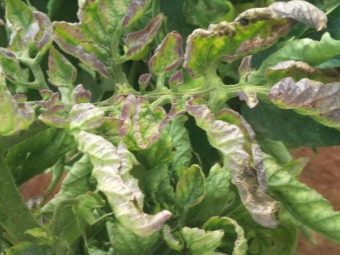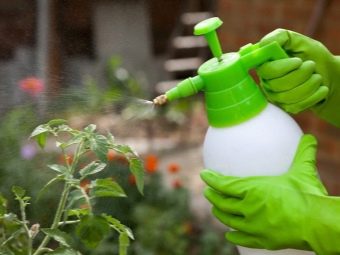Tomatoes "Volovye heart": features of a grade and productivity

The variety of tomatoes “Volovye heart” is known to many people, including those who are not engaged in gardening. He is loved for large, fleshy fruits with a sweet and sour rich taste.It turns out, in addition to the excellent taste, this variety is unpretentious in care.
Specifications
The name of the “ox heart” tomato is due to its appearance. These are large, rounded, fleshy and ribbed fruits of bright red color. The size of the fruit is also impressive - the weight can reach 900-1000 g. The fruits are fleshy, red and raspberry inside, juicy, sweet and sour.
The plant was bred by domestic breeders and in 2000 entered into the State Register. It is characterized by relative unpretentiousness and average productivity that allows to grow it both in hothouse conditions, and in an open ground.
Yield varieties can not be called high. On average, 4-7 kg of tomatoes are harvested from a bush planted in the ground, and up to 8-10 kg from greenhouses. This is understandable, because too much weight of tomatoes is already a simple test for the bushes. With a large number of them, the bush will simply break.
Variety refers to the middle and late ripening, matures for 108-115 day after sowing. Is non-hybrid, variety descriptions usually include information about the indeterminate nature of the crop. On open ground, bushes grow to 1.5 m, the height of greenhouse bushes can reach 2-2.5 m.
Due to the large weight of the tomatoes, it is recommended to grow them in 2 stems, and the plant must be tied up. Productivity is high, but to achieve it requires regular staving.
Suitable for consumption both raw and preserved. However, the whole to use them in blanks hardly succeed. Differs not very good keeping quality, therefore, for storage and transportation of fruits collected brown.
Virtues
The advantages of the variety include ease of care. Shrubs need standard conditions for this crop, so they can be grown even by beginner gardeners. It is important that the variety has genetic resistance to late blight and most fungal diseases.
A large number of reviews concerns the excellent taste. He is in this variety multifaceted, the fruit itself is juicy, fragrant. One tomato is sometimes enough for cooking salad for the whole family.
Since the variety is not a hybrid, seeds from the most successful tomatoes can be sown again in a year. From this the quality of the subsequent harvest will not suffer.
disadvantages
The inconvenience of growing is the need to sawhead bushes every 3-5 days, as well as the obligatory tying of bushes. Otherwise, you can not expect a good harvest, or the bushes just break under the weight of the fruit.
Gardeners note that the peel of tomatoes is quite dense, they rarely crack on a bush or during storage, but the keeping quality of fruits is low. With long-term storage, ripe tomatoes quickly become soft, lose their taste, so you have to pick them brown. However, this allows you to keep the crop fresh for a maximum of 3-4 weeks.
Growing points
The cultivation of the “Volovye heart” variety is produced by seeds that can be bought, or harvested independently of the fruit from last year. Seeds must be pre-selected, removing too small ones (no good seedlings will grow from them), empty, defective.
Identify the "dummy" allows a simple test - the seeds should be immersed in water. Empty and unusable float to the surface, suitable for seeding will sink to the bottom.
Further, the composition is disinfected in a weak solution of potassium permanganate. For this, 1 g of potassium permanganate is added to 1 l of water, and the resulting liquid is mixed thoroughly. The seeds are wrapped in a 2-ply gauze bag, which is dipped into the solution for disinfection and kept there for no more than 20-25 minutes.
Such actions eliminate the risk of seed infection, which is one of the main causes of adult plant immunodeficiency and low yields.
Next, the seeds are washed several times under running water. This should be done without taking them out of the bag.After that it is recommended to place it in a growth activator. The latter can be prepared personally or purchase more efficient ready-made version.
For self-production of a stimulating solution, mix a teaspoon of ash and 250 ml of distilled water at room temperature. The composition is mixed and left to stand for a day. After that, the seeds in a gauze bag are placed in this solution for 12 hours.
You can use ready-made solutions, the most famous of which is considered "Fitosporin". In it, the seeds are also kept for 12 hours.
After that, you can put them in the ground or pre-germinate, placing in a humid environment. In a gauze bag, the seeds are periodically moistened and placed in a warm place: usually a plate with seeds and water is placed on the battery. After the germination of seeds - they appear white "tails" - they are placed in the ground.
The grade shows good productivity on the enriched, acidified soils on the basis of chernozem, humus, a small amount of sand and peat. Excessive acidity can be reduced by adding ash.
Prepared soil should be calcined in the oven or treated with a solution of potassium permanganate. Seeds are sown in common crates or disposable cups, the latter being preferable, since the risk of infection is reduced. However, these cups are more expensive and require a lot of space on the windowsill.
Seeds are planted in pots by 2, in pots - in rows, a distance of 2 cm is maintained between seeds. They are buried 1.5-2 cm, covered with earth, after which the soil is moistened and closed with film or glass.
This will create optimal conditions for the emergence of shoots, but it is important that the temperature at this moment is not kept below + 23-25С.
After the first shoots appear, the protective film or glass is removed, and after the appearance of 2 leaves, the seedlings are thinned. Weak seedlings can be removed, strong ones can be transplanted into separate containers.
When caring for “Oxen Heart”, despite its unpretentiousness, it should be remembered that tomatoes are a southern culture. For their growth, it is necessary to maintain a temperature of at least + 22 ° C, as well as to ensure a long light day. To this end, it is recommended that seedlings be illuminated with a lamp in the wee hours and after sunset.
After 1.5-2 weeks after the appearance of seedlings, the seedlings are quenched, placed for 5-7 days in conditions lowered to + 15-18C temperature.
1.5-2 weeks before landing in the ground (they produce it on average 55-65 days after sowing), the tomatoes are re-quenched, bringing to the street. The duration of the “walk” starts from 20-30 minutes, gradually this time increases to 2-3 hours per day.
Transplantation into the ground or greenhouse occurs at the end of May - early June, but one should focus not on calendar dates, but on weather conditions. A prerequisite should be the absence of night frosts, night temperature indicators - no less than +10, soil temperature - no less than + 8C. When planted in cold ground, tomato bushes will adapt for a long time, which will cause a lag in development, and weak tomatoes may die.
The earth needs to be dug up from autumn and brought in humus. If this has not been done, you can add humus to the dug holes a few days before planting. To transplant tomatoes in the ground should be in a cool dry day, preferably in the evening.
The holes under the tomatoes dig a depth of 25-30 cm, pre-fertilize before planting the bush. The distance between the holes - about 40-50 cm. Per 1 m2 permissible to plant no more than 4 bushes.
It is important to monitor the crop rotation, it is impossible to arrange tomato beds in the place where potatoes and cabbage grew 1-2 years ago. But on the beds after onions, carrots, radishes, peas, tomatoes grow well. For tomatoes, you should choose areas that for a long time during the day sunlight gets, protected from drafts.
After planting the bushes is recommended to immediately tie up.At the same time it is necessary to use only synthetic materials, since natural ones cause rotting of the stems.
An important condition for the production of large tomatoes is the regular cracking. It is possible to form a bush from one or two stems. The second develops from the brush immediately under the first stem. All other stepchildren should be cut off. This should be done until such time as the processes have reached 5 cm. Otherwise, this process can be painful for the bushes and lead to its disease. For the same reason, it is not necessary to cut off all the processes for once.
The procedure should be carried out on a dry sunny day, so that the cut-off areas will heal faster. Together with the pinching they cut off the lower yellowed and simply sluggish leaves. After the formation of 5-6 brushes for soil tomatoes and 6-7 - for greenhouse the head is recommended to pinch. This will allow to get larger fruits.
Watering tomatoes is recommended every 5-7 days. In the heat, watering is made more frequent; in dry, cloudy weather, it is rare. It is impossible to use ice water, and also to allow stagnation of moisture. After watering is recommended to loosen the ground.
It is important to prevent drying of the top layer of soil, it will lead to a weakening of the root system.
To preserve the necessary indicators of humidity and temperature of the soil around the bushes resort to their mulching. Mulch is harvested from the bark, and straw will do. Thickness - about 5-6 cm.
During the period of growth and set of ovaries, tomatoes are fed 2-3 times with potash-phosphate fertilizers. After 5-7 days after transplanting, nitrogenous fertilizers can be applied to strengthen the root system. It is better not to use more nitrogen-containing fertilizer, as the bush will begin to increase the green mass. Given that the variety itself does not differ in its pomp and abundance of foliage, this will not be the best way to affect its fruiting.
With the development of bushes tie up, providing support for the trunk in several places, as well as supporting large brushes with fruits. Some gardeners use horizontal supports.
Crop harvested from late August to mid and sometimes the end of September. Do not rush to remove the fruit in dry sunny weather in the absence of frost. Otherwise, the harvest can be harvested brown and put to ripen in a warm dry place.
Diseases and pests
This variety is resistant to the appearance of fungal diseases, including phytophthora. However, improper care, primarily stagnant moisture, the absence of loosening the soil and too strong craps (already large processes), lead to the development of diseases.
If the beds with cucumbers or a field of potatoes around tomatoes are closely located, the level of humidity increases, which can cause fungus and rot on the trunk and sheets. Cure the plant allows treatment with special means. It is necessary to spray a plant not only from above, but also from the lower part of a leaf.
The usual soap solution will help to cope with aphids and cobwebs on tomatoes. You can also prepare a whey based on water, milk and a few drops of iodine. The same composition is considered an effective folk remedy against late blight.
If all means in the fight against late blight are useless, then the bush is recommended to be removed until the others have become infected.
On how to pick a tomato of the variety “Volovye heart”, see the following video.

